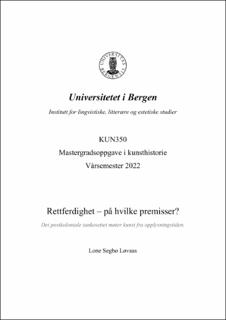| dc.contributor.author | Løvaas, Lone Segbø | |
| dc.date.accessioned | 2022-06-28T23:54:51Z | |
| dc.date.available | 2022-06-28T23:54:51Z | |
| dc.date.issued | 2022-05-20 | |
| dc.date.submitted | 2022-06-28T22:00:02Z | |
| dc.identifier.uri | https://hdl.handle.net/11250/3001388 | |
| dc.description.abstract | I løpet av våren 2020 ble rasisme diskutert verden over. En rekke statuer av mennesker, som på en eller annen måte representerer kolonial makt, ble angrepet og krevd fjernet av antirasistiske aktivister. Andre kunstverk som ble ansett som rasistisk ble også løftet fram og kritisert eller krevd fjernet i debatten. Denne ikonoklasmen kom som en reaksjon i kjølvannet av drapet på afroamerikaneren George Floyd og Black Lives Matter-demonstrasjonene som bredte seg verden rundt i etterkant av hans død. Den norske offentlige debatten ble også påvirket av dette, og flere aktivister rettet oppmerksomheten mot systemisk rasisme i Norge. I tillegg ble det uttrykt ønsker om å fjerne flere offentlige kunstverk på bakgrunn av at de enten viser rasister eller har rasistisk innhold. Ett eksempel kan vi finne i Bergen, hvor lokalpolitiker Paul Richard Johannessen argumenterte for at maleriet Rettferdigheten (1762) av Mathias Blumenthal burde fjernes fra bystyresalen i Bergen. Han mente at verket inneholdt rasistisk tematikk på grunn av framstillingen av en hvit kvinne som tråkker på en mørkhudet kvinne. Initiativet ble møtt med motstand, og hans motdebattanter argumenterte for at verket ikke burde fjernes fordi det tilhører en annen tid hvor folk hadde et annet syn på rasisme. Denne masteroppgaven er et forsøk på å bygge bro mellom disse to synspunktene, og reflektere over hvordan kunsthistorikere kan bidra med avpolariserende synspunkter i en ellers polarisert debatt om kunst. Gjennom å undersøke den postkoloniale og antirasistiske konteksten rundt Johannessens argument, samt den historiske konteksten motdebattantene hans viser til, skal jeg forsøke å vise at disse to sidene kan forenes for å skape et grunnlag for en interessant debatt. En debatt som i tillegg åpner opp for en samtale om et kunstverks liv og hvordan politisk ikonoklasme kan benyttes som et verktøy for å etablere og understreke sosiale forandringer. | |
| dc.description.abstract | During late spring of 2020, racism was heavily debated all around the world. Multiple statues of people who in some way represented colonial power were attacked and their removal was demanded by antiracist activists. Other artworks depicting imagery that was deemed racist received attention as well. This iconoclastic revolt came as a reaction in the aftermath of the murder of the African-American George Floyd, and the Black Lives Matter-demonstrations that spread around the world following his death. The Norwegian public debate was also affected by this, and many activists called attention to the systemic racism in Norway. There were calls for Norwegian public art to be removed on the grounds that it depicted either racists or racist imagery. One example can be seen in Bergen, where local politician Paul Richard Johannessen argued that the painting Rettferdigheten (1762) by Mathias Blumenthal should be removed from the seat of the city government, located in Bergen gamle rådhus. He viewed the work as containing racist imagery due to the depiction of a white woman standing on the chest of a darker skinned woman. The initiative was met with disagreement, and his opponents argued that the painting should not be removed, as it stemmed from a different time where people had a different view on racism. This thesis is an attempt to mediate these two views and reflect on the ways in which art historians can contribute to depolarising viewpoints in polarised debates about art. Through examining the postcolonial and antiracist context of Johannessen’s argument, as well as the historical context of his opponents’ arguments I will attempt to show that the two sides can be combined to create grounds for an interesting debate that also opens up a conversation around the life of an artwork and how political iconoclasm can be used as a tool to establish and emphasise social change. | |
| dc.language.iso | nob | |
| dc.publisher | The University of Bergen | |
| dc.rights | Copyright the Author. All rights reserved | |
| dc.subject | Mathias Blumenthal | |
| dc.subject | Rettferdigheten | |
| dc.subject | postkolonialisme | |
| dc.subject | Justitia | |
| dc.subject | Tisiphone | |
| dc.subject | norsk kunst | |
| dc.subject | Kunst | |
| dc.subject | 1700-tallet | |
| dc.subject | politisk ikonoklasme | |
| dc.subject | rasisme | |
| dc.title | Rettferdighet – på hvilke premisser? Det postkoloniale tankesettet møter kunst fra opplysningstiden. | |
| dc.title.alternative | Justice - On What Grounds? Postcolonial Thought Meets Art from the Enlightenment | |
| dc.type | Master thesis | |
| dc.date.updated | 2022-06-28T22:00:02Z | |
| dc.rights.holder | Copyright the Author. All rights reserved | |
| dc.description.degree | Kunsthistorie mastergradsoppgave | |
| dc.description.localcode | KUN350 | |
| dc.description.localcode | MAHF-KUN | |
| dc.subject.nus | 713203 | |
| fs.subjectcode | KUN350 | |
| fs.unitcode | 11-21-0 | |
